By Sarah Fecht
The world’s ocean waves hold as much as 10 trillion watts, and engineers and startup companies are racing to find the best ways to tap the incredible resource that’s washing up on our shores every day. These designs—inspired by beach caves, oyster shells and airplane wings—could point the way to harnessing wave energy.
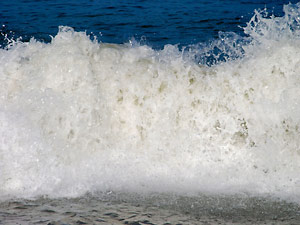
Far out at sea, the wind blows over the water’s glassy surface, creating tiny ripples and eddies. Those ripples provide a rough surface for the wind to grab and push—and waves are born. The longer a gust of wind catches the water’s surface, the bigger the waves become.
According to some estimates, ocean waves around the world could hold up to 10 trillion watts of energy. If humans could harness that energy, we would be able to generate renewable, predictable and pollution-free electricity. But so far, few large-scale wave-energy projects have made it off the diving board—which means that ocean-wave technology is a free-for-all in terms of design. “There are many, many different types of devices,” says Paul Jacobson, an ocean-energy leader at the Electric Power Research Institute. “The technology hasn’t developed to the point where a lot of the designs have been shaken out yet. And so it remains to be seen which devices will turn out to be the most cost-effective and efficient.”
These five ocean-power designs could help us to ride the wave into the future of energy.
The Oyster
Company: Aquamarine Power
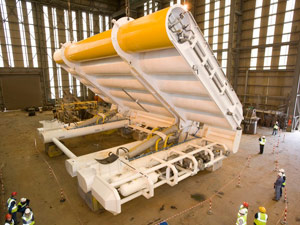
Much like its namesake mollusk, the Oyster sits on the seabed, opening and closing its jaws. The device is a large hinged flap attached to the ocean floor at a depth of about 35 feet. As the flap opens and closes, it drives hydraulic pistons that squirt high-pressure water onshore, where it drives a conventional hydroelectric turbine. “In essence, the Oyster is simply a large pump which provides the power source for a conventional onshore hydroelectric power plant,” says Carrie Clement, a spokeswoman for Aquamarine.
A 0.32-megawatt Oyster has already been installed in Scotland, where it began feeding power to National Grid in 2009. Now Aquamarine Power is working on creating a 2.4-megawatt Oyster bed in the Orkney Islands in Scotland. The submerged design protects Oyster’s equipment from storm damage and allows it to keep working in all kinds of weather.
The Pelamis Wave Energy Converter
Company: Pelamis Wave Power
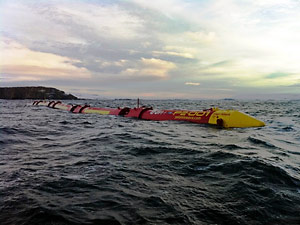
Floating on top of the water, the Pelamis device is the sea snake of ocean-power generation. It consists of four big cylinders strung together by hydraulic joints. As the tubes bob up and down on the waves, their movement pumps the joints, moving oil through hydraulic motors. Those motors drive generators to produce electricity.
Recent improvements in the design give the device’s joints universal mobility. The initial joint worked like a knee joint—it could only generate electricity from simple up-and-down or side-to-side movements. The new design acts more like the ball-and-socket joint of your shoulder. It can make electricity whether the segments are moving up and down, from side to side, or in any other direction. That increases efficiency at turning waves into energy.
Each Pelamis snake is 600 feet long and 13 feet wide and generates up to 0.75 megawatts—that’s enough to power about 500 homes for a year. Past projects have generated up to 2.25 megawatts, and Pelamis plans to set up similar ones at several sites in Scotland.
GreenWAVE
Company: Oceanlinx
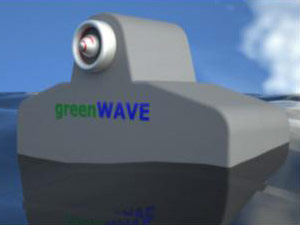
This design was inspired by Oceanlinx founder Tom Denniss’s youthful days on the beach. Like a blowhole cave on a rocky coastline, the greenWAVE consists of an underwater tunnel that opens on a cabin full of air that sits above the waterline. At the top of the cabin is a small hole with a turbine. As an incoming wave floods the device with water, it compresses the air inside the cabin, making it rush out the air vent. When the water recedes, the falling water creates a vacuum inside the chamber. That makes the cabin suck in air from outside.
When it’s working, the greenWAVE sounds like a big animal breathing, Denniss says. And as the vent breathes in and out, it turns a turbine hooked up to a generator. Each device measures 82 by 50 feet and has a 1-megawatt capacity. Oceanlinx has plans to develop a permanent version in Australia or Mexico, which it hopes to expand into a wave farm. GreenWAVE is relatively inexpensive as well, Denniss argues, because it’s made mostly of concrete, weathers ocean storms easily and has no moving parts underwater.
The Terminator
Company: The U.S. Air Force Academy
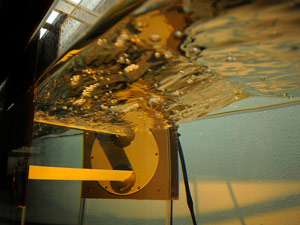
This model was inspired by airplane design. The wing-shaped turbine blades force water to flow faster over one side than the other, creating different pressures on each surface. This results in a “lift” toward the low-pressure side; lift is the upward force that happens when you hold your hand horizontally out the window of a moving car. In contrast, typical water turbines rely on drag, or the direct push of the water—like sticking your hand out flat against the wind. By employing lift instead of drag, engineer and owner Stefan Siegel says the device (theoretically) could use 99 percent of a wave’s energy, compared to the 50 percent efficiency or less that current tidal power projects can get. Siegel hasn’t tried the device in the ocean yet. He’s working to scale up the prototype to make it strong enough for testing off the coast of Texas later this year.
Autonomous PowerBuoy
Company: Ocean Power Technologies

The PowerBuoy has two main parts: a moving float that’s 5 feet in diameter by 5 feet tall and a 25-foot-tall spar anchoring it. When the float bobs up and down on the wave, it tugs on the spar. That stretching gets translated into electricity by a rotary motor and generator.
One significant challenge to the design, says Phil Hart, OPT’s chief technology officer, was getting the buoy to properly resist the waves. In order to get electricity out of puny waves, the resistance between the float and the spar needs to be low—otherwise, the weakling wave won’t move the buoy at all. But bigger waves contain more energy, and by increasing the force needed to move the float, OPT can harness more of that energy. Thus, PowerBuoy needs low resistance at some times and high resistance at other times. To solve the problem, they’ve implemented a computer that adjusts the device’s resistance 10 times per second, leading to a big increase in efficiency.
Each PowerBuoy currently operating off the coast of Hawaii has a capacity of 0.04 megawatts, but an upcoming installation in Scotland may be able to generate up to 0.15 megawatts.
Source: popularmechanics
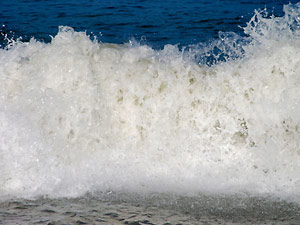
 Follow
Follow